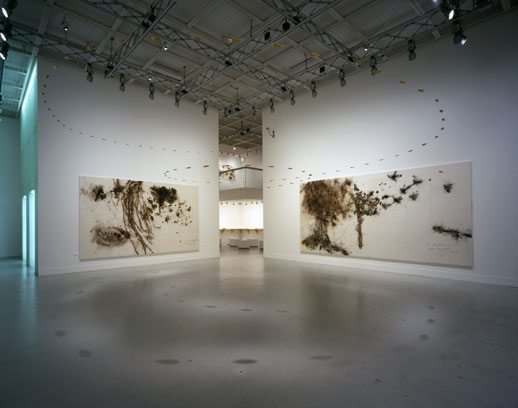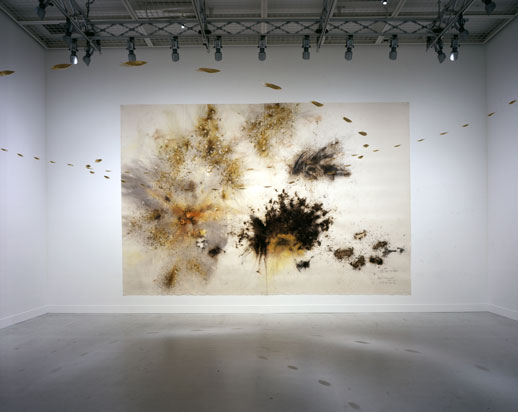Paintings by a Pyrotechnic

The most coveted spot at this exhibition is the center. From that vantage point, there is enough distance to take in the large panels, each of which is intended to depict a season, and while turning slowly, spring becomes summer, and so on, creating the passage of time that the artist takes as his theme. On a rainy Saturday when I visited the gallery there were many such visitors spinning on their own imaginary axes, someone appearing in my winter, me superimposed on his summer.
Cai Guo-Qiang works in an unusual medium, yet one that is familiar to him: gunpowder. He uses different shades of powder, namely metallic neutrals best described by their natural form (copper, rust, charcoal) or their contemporary manifestations (steel grey, gun metal), which he then ignites, leaving behind abstract images that hint at seasonal landscapes. For such a volatile material, Cai wields an impressive control over it, leaving what look like silhouettes of birds, fish, and leaves framed by bursts of color. I can’t imagine the process of trial and error he must have gone through in order to perfect this technique.
Cai’s reputation as one of China’s leading contemporary artists is backed up by a long list of credentials. He is perhaps best known for his ‘explosive’ installations, where the pyrotechnics themselves, usually on a grand scale and carried out in full view, are the attraction. In contrast, this exhibition is understated and introverted. Confined to four gallery walls, it concentrates on the aftermath: surprisingly beautiful, ‘constructive’ debris. A stream of tiny golden boats, or maybe extraterrestrial creatures, hang from above, rounding out the stark, yet delicate world view imaged in his drawings.

As contemplative as it might seem, however, the exhibit is far from peaceful. In the adjoining room a video shows highlights from Cai’s career, including many of his firework installations, and the bangs and whistles of these momentous explosions sound throughout the gallery.
Whether or not you are familiar with Cai Guo-Qiang’s work, the comprehensive video that documents his career is captivating. Behind the scenes footage shows Cai and his assistants digging trenches, laying bricks, and lighting fuses, much of which looks eerily like footage from the evening news concerning acts of terror or poor working conditions in China. His work is so ripe with riffs on past and present, east and west, earthly and ethereal that it is likely to be rattling around your head for days, if not weeks.
Throughout the video a recent interview between Cai Guo-Qiang and Shiseido executive Takao Kakizaki plays, which provides the commentary for the clips of his work. The whole thing seems a bit like a love fest between Cai and Shiseido and, well, it is. Shiseido, and Japan in general have been good to Cai since he first came here in 1987, then studying plastic arts and mixed media at the University of Tsukuba from 1989 to 1991. As the catalogs on display at the show illustrate, many of his early exhibitions were held in Japan, including the exhibition Promenade Asia at Shiseido, which was the culmination of an artist in residence program that Shiseido extended to several East Asian artists in 1994 and revisited again in 1997.
Despite the innovative works that play out in the basement gallery, the Shiseido building itself is beautifully classic, from the art deco designs on the packaged sweets for sale in the lobby to the coiffed ladies having tea in the café upstairs. In Tokyo, the Shiseido Gallery stands out as being centrally located on one of the city’s rare streets that qualifies as a boulevard, as well as for its commitment to a model of patron and artist that evokes a time before t-shirt and sneaker tie-ins. Okay, to be fair, it does kind of make me want to buy their cosmetics.
The final segment of the video has footage of Cai Guo-Qiang in Yokohama’s BankART Studio NYK creating the pieces displayed in the adjacent room. The clips, taken in June, show him working fast and precisely, in the way one expects a virtuoso to work, and even gives away a few of the technical secrets behind the gunpowder works. Not as if you were going to try it at home or anything…
Rebecca Milner
Rebecca Milner



